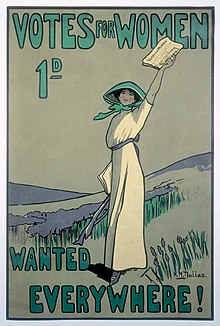
Back حق النساء في التصويت في المملكة المتحدة Arabic যুক্তরাজ্যে নারীদের ভোটাধিকার Bengali/Bangla Frauenwahlrecht im Vereinigten Königreich German Virina balotrajto en Britio Esperanto Sufragio femenino en el Reino Unido Spanish حق رأی زنان در بریتانیا Persian Droit de vote des femmes au Royaume-Uni French Pravo glasa žena u Ujedinjenom Kraljevstvu Croatian Vrouwenkiesrecht in het Verenigd Koninkrijk Dutch په انګلستان کې د ښځو د رایې د حق غوښتل Pashto/Pushto
| Part of a series on |
| Feminism |
|---|
 |
|
|

A movement to fight for women's right to vote in the United Kingdom finally succeeded through acts of Parliament in 1918 and 1928. It became a national movement in the Victorian era. Women were not explicitly banned from voting in Great Britain until the Reform Act 1832 and the Municipal Corporations Act 1835. In 1872 the fight for women's suffrage became a national movement with the formation of the National Society for Women's Suffrage and later the more influential National Union of Women's Suffrage Societies (NUWSS). As well as in England, women's suffrage movements in Wales, Scotland and other parts of the United Kingdom gained momentum. The movements shifted sentiments in favour of woman suffrage by 1906. It was at this point that the militant campaign began with the formation of the Women's Social and Political Union (WSPU).[1]
The outbreak of the First World War in 1914 led to a suspension of party politics, including the militant suffragette campaigns. Lobbying did take place quietly. In 1918 a coalition government passed the Representation of the People Act 1918, enfranchising all men over 21, as well as all women over the age of 30 who met minimum property qualifications. This act was the first to include almost all adult men in the political system and began the inclusion of women, extending the franchise by 5.6 million men[2] and 8.4 million women.[3] In 1928 the Conservative government passed the Representation of the People (Equal Franchise) Act 1928 equalizing the franchise to all persons, male and female, over the age of 21.
- ^ See NUWSS.
- ^ Harold L. Smith (12 May 2014). The British Women's Suffrage Campaign 1866–1928: Revised 2nd Edition. Routledge. p. 95. ISBN 978-1-317-86225-3.
- ^ Martin Roberts (2001). Britain, 1846–1964: The Challenge of Change. Oxford University Press. p. 1. ISBN 978-0-19-913373-4.
© MMXXIII Rich X Search. We shall prevail. All rights reserved. Rich X Search